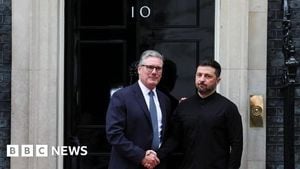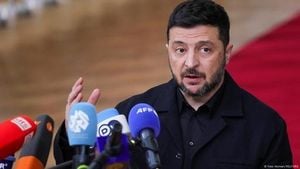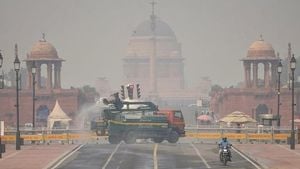The Argentine peso has plunged to fresh lows this week, revealing deepening anxiety among investors over the country’s financial stability, despite a high-profile U.S. bailout and repeated interventions by Argentina’s central bank. With legislative elections just days away, the embattled currency’s slide is stoking fears of further economic turmoil and political fallout for President Javier Milei’s administration.
On Monday, October 20, 2025, the peso’s value tumbled as markets signaled skepticism that the government could maintain its carefully managed trading band—a policy meant to prevent wild swings in the exchange rate. According to Reuters, the latest blow came even as Argentina’s central bank announced a major agreement with the U.S. Treasury: a $20 billion swap line designed to provide the country with much-needed access to dollars. But for many investors, the move wasn’t enough to restore confidence or stem the rush towards safer dollar assets.
The new swap line, formalized in a statement from Argentina’s central bank, is intended to shore up the country’s dwindling reserves and guarantee payments on its next public debt maturity. Yet, as Bloomberg reports, analysts remain unconvinced that the measure will end the peso’s currency crisis. “We have the capacity to act with flexibility and with force to stabilize Argentina,” U.S. Treasury Secretary Scott Bessent insisted at a press conference on Friday, October 17, 2025. In an effort to back up those words, the Treasury has already purchased pesos on the open market at least twice in recent weeks, aiming to support the currency’s value.
Still, the skepticism is palpable. On Tuesday, October 21, 2025, Argentina’s central bank was forced to sell $45.5 million from its reserves in a bid to prop up the peso after it hit the upper limit of its floating band. According to La Nación, this intervention left the central bank’s international reserves at $40.539 billion—a figure that, while substantial, continues to shrink under the strain of repeated market interventions and persistent capital flight.
The managed floating band, introduced last April, is supposed to offer a buffer against extreme volatility by allowing the peso to trade within a set range. On Tuesday, that band sat between 938.33 and 1,491.07 pesos per U.S. dollar for buying and selling, respectively. But the peso’s sharp drop—closing 0.7% lower at 1,490.5 per dollar after reaching record lows—shows just how close the currency is to breaking out of its carefully maintained boundaries.
What’s driving this crisis of confidence? Much of it comes down to politics. The legislative elections scheduled for Sunday, October 26, 2025, have injected a fresh dose of uncertainty into an already jittery market. President Javier Milei’s party, which currently holds a minority in both chambers of Congress, is pushing hard to gain more seats. But recent signs of political weakness have put his administration under pressure, making investors nervous about the government’s ability to manage the economy and honor its debts.
As election day approaches, market participants are bracing for further volatility. According to Financial Times, the pre-election exchange rate tensions have been exacerbated by a widespread shift toward dollar assets, as both institutional and retail investors seek to shield themselves from potential peso devaluation. The central bank’s interventions, while necessary to keep the currency within its band, have only fueled concerns about the sustainability of Argentina’s foreign reserves.
President Milei’s decision to seek U.S. support for the $20 billion currency swap underscores just how precarious the situation has become. The deal, which was finalized on Monday, is seen as a lifeline—at least in the short term. But as Reuters points out, it also highlights Argentina’s dependence on external assistance to meet its obligations and maintain a semblance of stability in its financial markets.
For ordinary Argentines, the peso’s slide is more than just an abstract economic problem. It means higher prices for imported goods, eroded savings, and a growing sense of insecurity about the future. As the cost of living continues to rise and wages struggle to keep pace, frustration is mounting—fueling a political climate that’s as volatile as the currency itself.
Market analysts are divided about what comes next. Some believe that the combination of U.S. support and central bank interventions could buy the government enough time to weather the immediate storm, especially if the election results provide a clear mandate for economic reforms. Others warn that unless Argentina addresses the underlying structural issues—chronic inflation, fiscal deficits, and a lack of investor confidence—the peso’s troubles are likely to persist.
In the meantime, the central bank’s managed band remains under constant pressure. Each intervention to support the exchange rate depletes reserves further, raising questions about how long the government can afford to keep defending the peso. As the band’s upper limit is repeatedly tested, the risk of a disorderly devaluation looms ever larger.
Secretary Bessent’s pledge to act “with flexibility and with force” has been welcomed by some in Argentina’s business community, who see it as a vote of confidence from Washington. Yet, as Bloomberg notes, international support can only go so far if domestic policies fail to restore trust in the peso. The real test will come in the weeks following the election, when the new Congress must confront the daunting task of stabilizing the economy and rebuilding credibility with both local and foreign investors.
For now, all eyes are on Sunday’s vote. The outcome could determine not just the balance of power in Congress, but also the trajectory of Argentina’s financial crisis. Will President Milei’s party gain the strength it needs to push through reforms and reassure jittery markets? Or will continued political gridlock and economic uncertainty drive the peso to new lows?
As the country stands at a crossroads, the stakes couldn’t be higher. The peso’s fate—and by extension, the future of Argentina’s economy—hangs in the balance, awaiting the verdict of both voters and markets.





